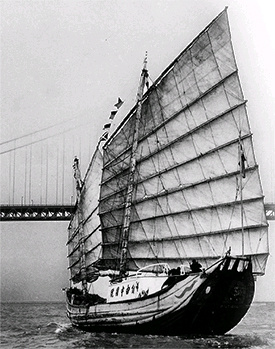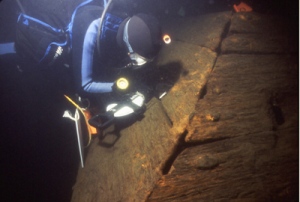 Faced with imminent destruction, the junk will be saved. More than four years after I launched efforts to save the Free China, and nearly 57 years after his historic trans-Pacific crossing from Taiwan to San Francisco, the junk will make its return trip to Taiwan later this spring, where it will be preserved as an museum exhibit there, thanks to the Taiwan government. The junk– which is the oldest Chinese wooden sailing vessel and last of its kind in existence– will generate awareness of Chinese maritime achievement and culture and the Chinese diaspora. There are several unique aspects of this preservation project.
Faced with imminent destruction, the junk will be saved. More than four years after I launched efforts to save the Free China, and nearly 57 years after his historic trans-Pacific crossing from Taiwan to San Francisco, the junk will make its return trip to Taiwan later this spring, where it will be preserved as an museum exhibit there, thanks to the Taiwan government. The junk– which is the oldest Chinese wooden sailing vessel and last of its kind in existence– will generate awareness of Chinese maritime achievement and culture and the Chinese diaspora. There are several unique aspects of this preservation project.
First, the movement of the junk to Taiwan will be an extremely complicated and delicate task. The junk will be fit with a temporary cradle and transported to Antioch aboard a truck (requiring possible road closures and police escorts) for its journey to Antioch, where a stronger cradle will be built to ensure the safe transportation of the now-frail vessel. From Antioch, the junk will then be loaded onto a barge and then lifted by crane onto a freighter ship for the ocean crossing. The Taiwan government is in the process of making plans for a farewell reception to see the junk off.

The Free China about to pass under the Golden Gate Bridge (Photo courtesy of The Oakland Tribune).
Second, while the maritime world is dominated by men and the Free China’s crew was all male, women are playing key roles in ensuring the success of this preservation project. Diane Shipway, of Parker Diving Service, is a marine salvage operations expert, and will be in charge of managing the complex logistics involved in transporting the junk. Yiching Lin, Consular Officer with the Taiwan Economic and Cultural Office, is representing the government of Taiwan in its mission to ensure the safe return of the junk. Diana Waldie, manager of the Marine Emporium boatyard where the junk has remained since it was abandoned there several years ago, has continued to keep an eye on the old vessel. And finally, this project is the fulfillment of my dream of saving this forgotten piece of history. After my father’s death in the fall of 2007, I tracked down the junk and found it on the verge of destruction, and decided to launch a non-profit organization, Chinese Junk Preservation (www.chinesejunkpreservation.com) to save the junk in honor of my father, and with the hope of inspiring others to appreciate and preserve their family history.
Third, the junk has succeeded in surviving to this day because of the goodwill and love of a hugely interesting cast of local personalities and organizations on both sides of the Pacific, including the surviving members of the crew and their families, the Taiwan government, the National Park Service, Chinese Historical Society of America, National Trust for Historic Preservation, and interest by the media, whose coverage enabled us to broadcast our search for a new owner and “safe harbor” for the Free China. Historic preservation is an enormously challenging task, and the story of the Free China is a happy one of cooperation. I am grateful for the help of many.
Read the rest of this entry ?


 Faced with imminent destruction, the junk will be saved. More than four years after I launched efforts to save the Free China, and nearly 57 years after his historic trans-Pacific crossing from Taiwan to San Francisco, the junk will make its return trip to Taiwan later this spring, where it will be preserved as an museum exhibit there, thanks to the Taiwan government. The junk– which is the oldest Chinese wooden sailing vessel and last of its kind in existence– will generate awareness of Chinese maritime achievement and culture and the Chinese diaspora. There are several unique aspects of this preservation project.
Faced with imminent destruction, the junk will be saved. More than four years after I launched efforts to save the Free China, and nearly 57 years after his historic trans-Pacific crossing from Taiwan to San Francisco, the junk will make its return trip to Taiwan later this spring, where it will be preserved as an museum exhibit there, thanks to the Taiwan government. The junk– which is the oldest Chinese wooden sailing vessel and last of its kind in existence– will generate awareness of Chinese maritime achievement and culture and the Chinese diaspora. There are several unique aspects of this preservation project.
 I came to the field of maritime history like many of my colleagues did– serendipitously. My original area of expertise was in immigration and ethnicity, but when I was asked to teach a course in US Maritime History, I jumped at the chance: faced with a growing family and shrinking assets, it seemed like a good opportunity. Plus, how hard could it be: after all, most immigrants came to this nation via ship!
I came to the field of maritime history like many of my colleagues did– serendipitously. My original area of expertise was in immigration and ethnicity, but when I was asked to teach a course in US Maritime History, I jumped at the chance: faced with a growing family and shrinking assets, it seemed like a good opportunity. Plus, how hard could it be: after all, most immigrants came to this nation via ship!
 Throughout a thirty-year career in maritime archaeology, a particular hobby-horse of mine has been an element of good practice management that involves jointly sharing heritage responsibilities, as well as benefits and outcomes.
Throughout a thirty-year career in maritime archaeology, a particular hobby-horse of mine has been an element of good practice management that involves jointly sharing heritage responsibilities, as well as benefits and outcomes.